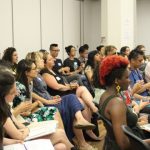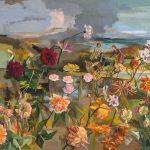Conversations | Cândida Borges
The IAP mentor and former mentee shares her six considerations for immigrant artists in New York City.
Cândida Borges is a Brazilian musician, transmedia artist, educator, composer, researcher, and IAP participant based in New York City. Her latest work, the Transeuntis Mundi Project, includes a virtual reality installation and sound and image works on the theme of human migration and cultural heritage. This work is a result of her Ph.D. research, pursued at the School of Art, Design and Architecture of the University of Plymouth (United Kingdom). She focuses on new media technology art to compose and express a diverse cultural background.
Her award-winning work has been exhibited worldwide. Besides interdisciplinary works with sound, video, and performance, her career as a musician includes multiple albums, soundtracks, concerts, and shows in the classical and electronic music scene. Learn more about her trajectory below.
NYFA: How has living in New York City influenced your career?
Cândida Borges: In New York City, I could expand my understanding about art, about life, and about people. Being exposed to such a huge amount of diversity and opportunities to watch or engage in different projects made me finally find a broader space for acting as an artist. From a one-disciplinary perspective as a musician to a transdisciplinary perspective as a transmedia artist, it reinvented my way to be in the world and how I interact with an audience so rich.
NYFA: Can you tell us about your project Transeuntis Mundi?
CB: This is the main project I am working on at the moment. It is about human and cultural diversity, and it is my gift to New York. Here, I learned we have history; I could discover myself beyond my local community and see that we are made of so many parts of the world: the collectiveness. This is the work: an homage to the human cultural heritage that resulted from millennial walks and migrations. I’ve been experimenting with video for the past few years and this is my first work with virtual reality. I’m absolutely amazed by these possibilities of composition and immersion.
NYFA: How do you find opportunities to show your work and collaborate?
CB: The key is my absolute discipline to deal with the administration of my career in a professional way. From searching for grants to reaching out to producers and agents, I do all this very consistently and I believe it is something fundamental nowadays. I would also say that when I got here, I already had a career as a musician. I also have been moving between different countries and cities for a while, so my networking is quite strong.
NYFA: What advice do you have for immigrant artists that are trying to push their career forward?
CB: There is this list I wrote at one of the meetings of the Immigrant Artist Mentoring Program (IAP) at NYFA. Being a mentor for the third year, and starting as a mentee five years ago, I started to realize how the game is played …
These are my six considerations for Immigrant artists in New York City:
- Study art business and career management just like you practice your craft.
- Consider your origin and authenticity very closely. We are stories; we are not degrees, CVs, or universities. And we are not universal. The world is looking for new stories and real ones.
- Consider your migrational stage. No, opportunities are NOT the same, so strategies can’t be either. Consider the kind of visa you have, the language you speak, your level of local networking, etc. Your citizenship will impact tremendously your chances to survive since certain grants are only available to U.S. citizens, Canadians, or Europeans. Also, if you don’t have long-time friends in New York City, you can consider this a huge impact, too, and have to work 10 times more on networking.
- Decolonize technique–there is no such thing as “the best" technique in the world. There are many different ways of doing something. Look very closely at the way artists express themselves in your home country. There is a lot to learn (and respect) there!
- New York is not the center of the world, the universe, or whatever. Consider the rest of the world as full of amazing opportunities, too.
- Be healthy and happy. This should be the number one priority in our life, even before being an artist anywhere in the world.
More about Cândida Borges
Borges is also an academic artist, currently a Visiting Scholar in the Department of Computer Music at Columbia University in New York; a Fellow Researcher for the Department of Arts at Antioquia University in Medellín, Colombia; and an Associate Professor at the School of Music at the Federal University of the State of Rio de Janeiro in Brazil, since 2009. She holds Masters and Bachelors degrees in Piano Performance (UFRJ), a specialization in Music Production (SAE), and she has been working as an invited Professor and speaker for international institutes such as Montclair State University (USA); Moving Arts Lab Festival (USA) and Federal University of Rio de Janeiro (UFRJ/ Brazil), among others.
– Interview Conducted by Alicia Ehni, Program Officer
This post is part of the ConEdison Immigrant Artist Program Newsletter #124. Subscribe to this free monthly e-mail for artist’s features, opportunities, and events. Learn more about NYFA Immigrant Artist Mentoring Program.
Image: Cândida Borges, Photo Credit: Andrew Sainte Howard






